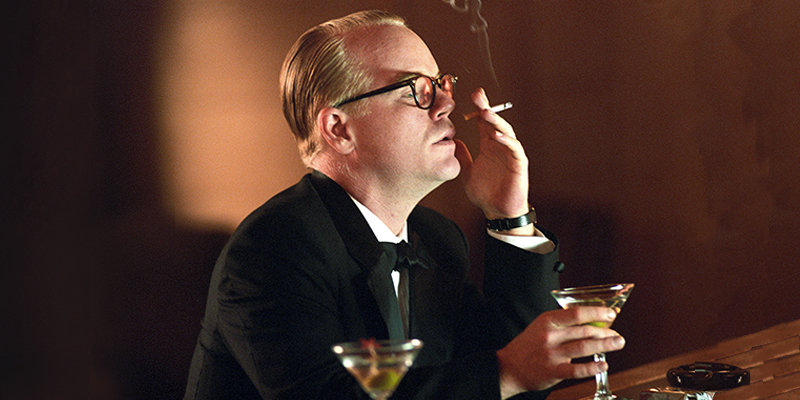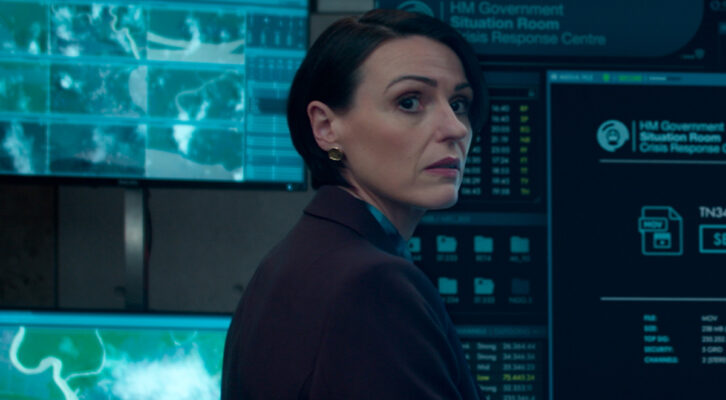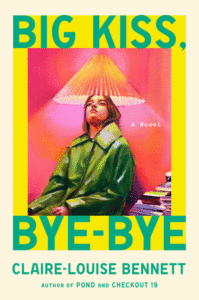What does it mean, and what does it cost, to write about crime? In Cold Blood, Truman Capote’s true crime masterpiece, was a massive hit; it remains one of the finest examples of the genre. The author described the book as a “nonfiction novel”–a work that narrates real events with the style and art of literature. It suggested a new approach to non-fiction crime writing that would be hugely influential. It took Capote six years to write In Cold Blood, and it made him rich and famous. But he would never complete another book, and became more known as a talk-show personality than an author.
Bennett Miller’s Capote, released 20 years ago today, argues that In Cold Blood was both a blessing and a curse for its gifted, ambitious, and troubled creator. The film is a quietly enthralling depiction of the story behind the story. (It is adapted from Gerald Clarke’s biography of the same name.) Capote is both a gripping retelling of these horrifying crimes and a moral fable of a writer’s struggle with his own self-interest and divided loyalties.
In Cold Blood tells the story of the killings of four members of the Clutter family in a small Kansas town. The book deftly traces the effects of the crimes on the Clutters’ friends and neighbors, and the terror felt by the community before the killers are caught. It memorializes the family, drawing detailed portraits of the father, Herb, the mother, Bonnie, the son, Kenyon, and the daughter, Nancy. But it pays equal if not more attention to the lives and psychology of the killers, Richard Hickock and Perry Smith, two ex-con drifters who embody the alienation of a criminal underclass. The book’s final section covers Hickock and Smith’s trial and the long journey to their executions. The reader leaves the book with the sense of justice done, but also with an unresolvable sadness about so many senseless deaths.
Capote shows how the crafting of the tale created this dichotomy. It follows the creation of In Cold Blood from its genesis (when a newspaper article about the murders piques Capote’s interest) to its conclusion (as he impatiently and queasily waits for the killers’ executions so the book can have an ending). Capote (played by Philip Seymour Hoffman, in an Oscar-winning performance) travels to the Kansas heartland and initially struggles to gain the confidence of the townspeople and investigators. With the help of his friend, To Kill A Mockingbird author Harper Lee (called Nelle by her friends, and played by Catherine Keener), he gains their trust. He also ingratiates himself with them with his cosmopolitan sheen and charm.
We see Capote’s interest in the story broaden: what he first sees as the tale of a small-town community wrecked by an unspeakable tragedy becomes a larger saga of crime and punishment. Once Smith and Hickock are caught, Capote develops relationships with the killers, especially the sensitive and damaged Smith (Clifton Collins Jr.). These bonds are complicated not only by his struggle to reconcile their humanity with the horror of their crimes, but also by his often manipulative attempts to leverage what they need from him to get what he needs from them.
Capote’s research trip begins as he develops a friendship with chief investigator Alvin Dewey (Chris Cooper) and his wife (Amy Ryan). These are warmer, occasionally festive scenes. Gathered together in the kitchen, the authors and the family grow closer as it becomes apparent that the investigation is taking a real toll on both husband and wife, and that they need to unburden their troubles. Similarly, Capote shares something of himself as he discusses his difficult childhood, and both the Deweys and the spectator see a side of him that he rarely reveals. His description of the aftermath of his mother’s death works both as a calculated icebreaker and a moment where the mask truly slips and vulnerability emerges.
The tone grows darker as the focus shifts to Capote’s relationships with Hickock and Smith. He comes to see the pair as undeniably human monsters. He grows increasingly interested in Smith, who seems more tragic and nuanced than the more direct and less repentant Hickock. Capote offers Smith real friendship, telling him how their troubled childhoods make them kindred spirits. “It’s as if Perry and I grew up in the same house,” he tells Nelle. “And one day he stood up and went out the back door while I went out the front.”
Yet every gesture of kindness towards the killers also serves his own ends. Capote goads Smith into handing over his journals, promising to use them to make Smith seem more sympathetic. But he withholds his friendship as he pressures Smith to face his inhumanity and tell the story of the murders in detail. He helps Hickock and Smith obtain lawyers because delaying their executions will give him more time to interview them. Then he changes his tune when he realizes that a speedier execution will help him finish the book.
Keenly aware of these profound tensions, Hoffman’s performance is deep and multifaceted. You can’t take your eyes off him. His Capote is empathetic, appraising, and withholding all at once. This is not a straight impersonation. Capote’s trademark high-pitched voice becomes stronger and less nasal. Hoffman’s posture and mannerisms are carefully (sometimes artfully) contained. Hoffman is rarely as loose and flamboyant as you see Capote in the many clips of him on talk shows. Perhaps the actor feared that he might teeter into the swishy: one hand is not quite limp, but consciously posed and always ready for artful articulation. It seems to capture something about Capote’s stylized self-presentation, emphasizing his tendency to be captivating and engaging without being stereotypical.
The performance is deliberate and studied (at moments a bit too much so), but the overall impression is of a calm, still presence that barely hides shrewdly observant eyes.
Hoffman seamlessly captures the different Capotes: the pensive and all-seeing author, the beguiling entertainer who holds court in New York’s literary circles, and the more nakedly human one who is moved and overwhelmed by facing Dick and Perry’s imminent deaths. He masters the wrenching moment when he meets with Dick and Perry just before their executions. Capote’s whole body is stricken by sorrow and guilt; his face practically convulses as he struggles to utter words that can only be inadequate.
Capote also boasts a gifted supporting cast. Keener’s Nelle, who is Capote’s steadfast but not-always-heeded conscience, wears her fundamental sincerity with a quiet ease. She is soft and true even as she sees her friend’s many faults, and meets them with the gentlest of reproaches. (Capote’s long-term partner Jack Dunphy, played with similar deftness by Bruce Greenwood, also tries to keep him grounded.) As the dogged Dewey, Cooper is both savvy and stoic, though not totally unable to resist Capote’s glamour. In the pivotal role of Smith, Collins, with his hangdog face, soulful aura, and pathetic self-importance, fully embodies someone that you might both fear and pity. He can make you forget (as Capote seems to do) the brutality of his actions and the antisocial side of his personality.
Much as In Cold Blood’s prose balances Capote’s authorly flair with the straightforward clarity of straight journalism, Capote balances a kind of spare look streaked with moments of dark beauty. The plains and homesteads of Kansas are portrayed in stark simplicity, with muted hues and a sometimes mournful solitude that reflects the mood of the townspeople. This plain bleakness often hits you in the gut, but this template is broken up with striking shot compositions. Deep focus creates a mysterious atmosphere, visually manifesting what is known and unknown, not just about the crime but the personalities involved. Dull, blurry figures surround Capote, in clear focus and brightly lit to represent the pull of his charisma. The scene of Hickock and Smith’s perp walk, where they’re finally brought to the local jail and the town gathers to see them, is particularly compelling. Through careful camera movement, the grand spectacle of the moment gets reduced to a first encounter between Capote and Smith, hinting at the sympathy the writer will grow to feel for the murderer. The prison scenes sometimes have a chiaroscuro look, and sometimes plunge totally into deep shadows. Tight shots and the presence of the prison bars convey a place of inescapable confinement. Director Miller, cinematographer Adam Kimmel, and editor Christopher Tellefsen create a world that first seems simple but often thrills and chills you.
As much as it works as a biopic and a morality play, Capote is a retelling of In Cold Blood’s terrifying story of these senseless murders, the investigation, the capture of the killers, and the brutality of their executions. The film follows the same narrative arc as the book, beginning with the discovery of the Clutters’ bodies and withholding the description of the murders (as told by Smith) until close to the end. The sense of suspense and horror in the film is almost equal to that of the book itself. This aspect of the film is controlled and well-paced, deepening its portrayal of the author at work.
Capote only hints at the troubles that will plague Capote’s later life–an unquenchable thirst for alcohol and an equally insatiable desire for fame. But they tinge an already dark story with a melancholy strain that intensifies the film’s interest in the mental strain and ethical dilemmas inherent to telling this kind of story. It is this keen depiction of the cost of encountering and reporting about crime that makes Capote something much more than the average biopic, and a film well worth revisiting.












